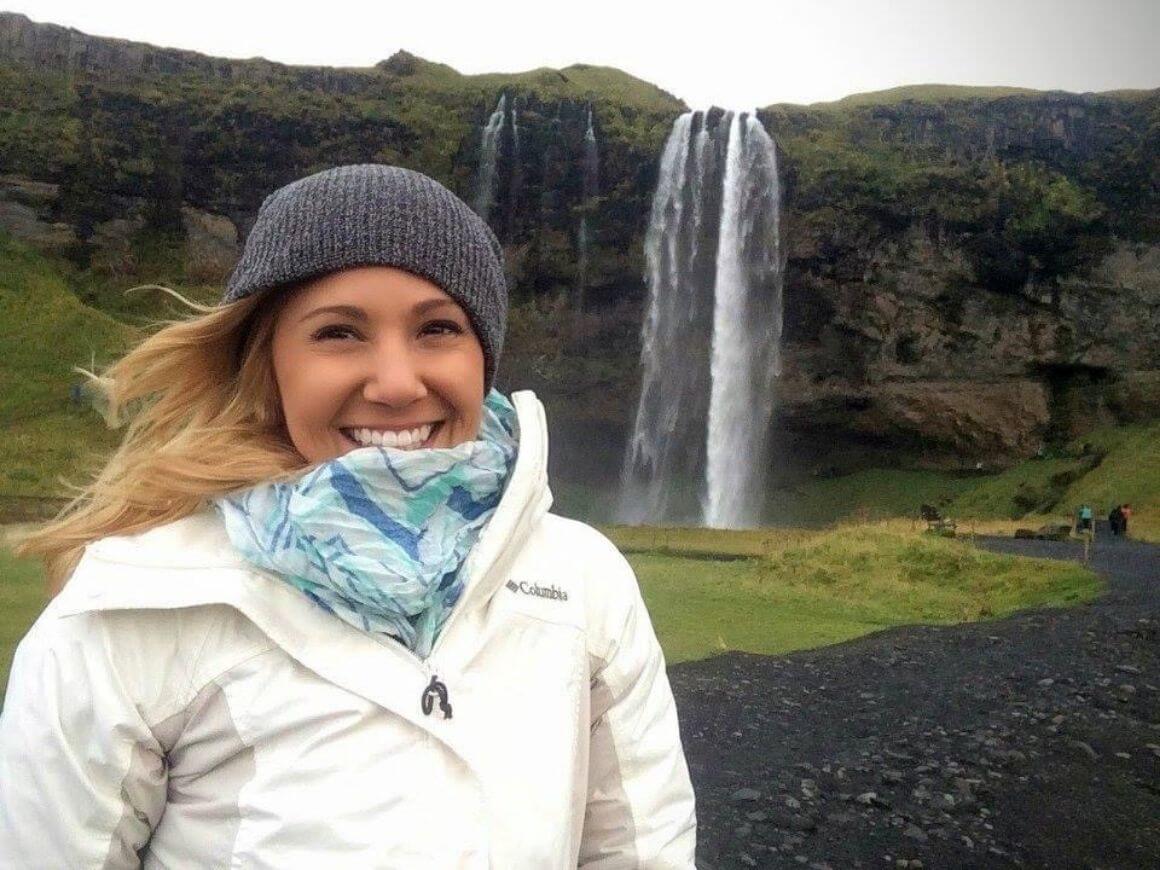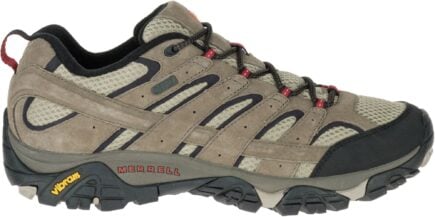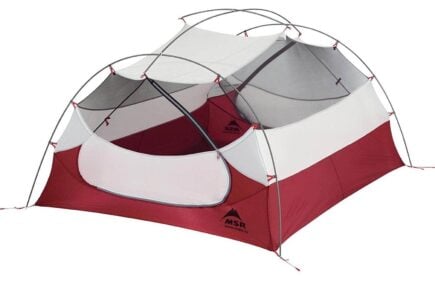The Broke Backpacker is supported by you. Clicking through our links may earn us a small affiliate commission, and that's what allows us to keep producing free content 🙂 Learn more.
Are you looking for the kind of destination that seamlessly combines adventure with ethereal sights? If so, Iceland certainly has you covered…
A mystical land where glacial wilderness contrasts magnificently soothing green terrains, Iceland is a hiking dream come true. There are endless hiking opportunities in Iceland, from geothermally active areas to lava fields and the many (and I do mean many!) crashing waterfalls speckled across the Golden Circle. From multi-day treks to shorter, family-friendly hikes, there’s nothing that the trails in Iceland can’t offer.
As exciting as the opportunities are though, remember that spontaneous hikes can be dangerous. I spent a lot of time mapping and planning out my hikes. You’ll also need places where you can crash for the night (especially on multi-day expeditions) and equip yourself with the right gear.
I got seriously overwhelmed planning some hikes. So this is exactly why I’ve crafted the perfect adventure in Iceland for you.
Hiking boots at the ready – we’re heading on the most EPIC Iceland adventure.
What to Know Before Hiking in Iceland

The Broke Backpacker is supported by you. Clicking through our links may earn us a small affiliate commission, and that's what allows us to keep producing free content 🙂 Learn more.
One of the (many) great things about planning a hike in Iceland is the sheer diversity of terrains that await. Indeed, you’ll come across just about every landscape you can think of, from lava fields to glaciers, barren landscapes, and moonscapes alike!
There’s no denying that backpacking Iceland is an absolute adventure. But hiking opens up the kind of landscapes you miss out on otherwise.
The country consists of a main volcanic plateau – peppered with ice fields and towering peaks alike. Iceland’s surface is dominated by epic glaciers and lava fields.
For the most part, Iceland offers a glorious medley of cliffs, peaks, plateaus, valleys, and lush lowlands. If you time your trip just right, you’ll even get to hike under the Northern Lights!
Several trails cross through the parks, giving you a chance to explore the world-class national parks in Iceland. Self-guided hikes are free in Iceland, so you won’t need a permit. Wild camping isn’t really allowed, so whether you’re staying in a camper van or tenting, you need to stick to designated camping areas.
For your own safety, you’ll need to pack your hiking gear carefully before facing that notorious Icelandic wilderness. But more on that later!
Iceland Trail Safety
Because of the Gulf Stream, Iceland has mild winters with an average temperature of 0°C and refreshing summers between 10-13°C during the day. Perfect for hiking, right?
Having said that, the weather in Iceland is extremely unpredictable. So you really need to prepare for all eventualities. You can start off your hike in sunny conditions – only to be faced with a sudden drop in temperature or windy conditions on the way back.

When hiking in Iceland, you also need to take into account that while summer sees crazy amounts of sunshine (up to 20-23 hours in June!), days are super short in the winter. If you’re planning on hiking in December – bear in mind that you’ll only have around 4 hours of sunlight per day. You MUST be well prepared if you’re attempting it!
Here are a few more things to consider before venturing out on the trails:
- Plan your hike: Whether you’re a novice planning one of your first hikes or a more experienced trekker, always take time to map out and properly plan your hike before hitting those trails.
- Always keep someone posted: It’s so important to always tell someone where you’re going. It’s all too easy to get lost in those vast plateaus, which is why it’s super important to have the right gear, including a first-aid kit.
- Get Insured: may wish to consider getting travel insurance before planning your hiking trip. Iceland may be a safe country, but it does feature some pretty dramatic landscapes. Travel insurance with hiking cover will go a long way in ensuring you’re well taken care of if anything happens.
- Carry a water bottle: Water isn’t always available on the trails, so a filter water bottle is invaluable. This means you can fill up from any water source.
Wondering what else you’ll need to pack for your trip? Then be sure to check the end of the article where you’ll find a handy list of hiking essentials!

Wanna know how to pack like a pro? Well for a start you need the right gear….
These are packing cubes for the globetrotters and compression sacks for the real adventurers – these babies are a traveller’s best kept secret. They organise yo’ packing and minimise volume too so you can pack MORE.
Or, y’know… you can stick to just chucking it all in your backpack…
Get Yours Here Read Our ReviewThe Top 8 Hikes in Iceland
Okay, enough with the heavy and let’s check out some of the most epic adventures that await in Iceland!
Here’s my carefully curated list of the top trails in Iceland to start your trip off right.
- Reykjadalur Hot Spring Hike – The best day hike in Iceland
- Fagradalsfjall Volcano Hike
- The Askja Trail – The best multi-day hike in Iceland
- Mount Blahnúkúr Hike
- Oxararfoss Waterfall Hike – A fun, easy hike in Iceland
- Fimmvörðuháls Hike
- Skógar to Landmannalaugar Trek – The toughest trek in Iceland
- Glymur Waterfall
1. Reykjadalur Hot Spring Hike – The Best Day Hike in Iceland

Image: Ankita Kumar
The Reykjadalur Hot Spring trail seems like a good place as any to start off this list of best hikes in Iceland. Not only is this out-and-back hike easily accessible if you’re staying in Reykjavík it’s also dreamy for watching the Northern Lights – especially if you’re visiting Iceland between late August and mid-April.
The hike’s starting point is just a short distance from Hveragerdi, a quaint town that lies around 40km from the capital. To get there, you can catch a Strætó bus from Reykjavík ($7 to $35 for the 40-minute journey) which goes every 3 hours. If you’re renting a car, you can take the Þjóðvegur 1 road and drive onto Hveragerdi.
While this hike is quite short and easy, it’s one of the most panoramic trails that I explored in Iceland. When the weather is clear, you can catch the smoky mountains and the ocean glistening in the distance.
The trail leads into a geothermically active area, complete with a geothermal river, mud pools, and hot springs. Don’t forget your swimwear!
The hike takes you across a wooden bridge that leads to a steep, uphill terrain. Rest assured that the uphill climb does level out after a few minutes, leading to an easy walk across a well-maintained path. There are a few ups and downs as you make your way through the hilly topography to the geothermal river, but the walk isn’t strenuous.
It won’t take you long to spot sulphur pockets dotted across the ground. Remember that touching sulfurous water is highly dangerous since they often bubble up to dangerous temperatures. Keep your eyes peeled for the many signboards that indicate the water temperature.
After walking past the Sulphur pockets, you’ll eventually reach a wooden platform overlooking the geothermal river. While the river is safe for swimming, it’s often packed with hikers who want to enjoy a refreshing dip after their walk. I would recommend that you head there earlier in the morning to avoid the crowd.
- Length: 6km
- Duration: 3 hours
- Difficulty: Easy
- Trailhead: Hveragerdi, 63.9984° N, 21.1886° W
2. Fagradalsfjall Volcano Hike

Image: Ankita Kumar
Okay, first things first: while there’s no doubt that this is easily one of the best trails in Iceland, the Fagradalsfjall Volcano is dormant, not dead.
In fact, Fagradalsfjall roused itself from a 6,000-year-old slumber to erupt once in 2021, and again in 2022. As such, it’s crucial to check the local meteorological website for current safety information before heading out. Weather changes can be quite abrupt in Iceland, so hiring a guide for safety is never a bad idea.
While it’s not uncommon to see hoards of tourists flocking to this site, the good news is that there are numerous, less crowded, hiking paths. If you’re looking for a quickie (cheeky ;)), I would recommend that you kick off on Path C by Nátthagi. This 2 km trail is quite easy – although it ends at the lava field – so you won’t see the actual crater.
Personally, I prefer Path A which starts from the parking lot. If you need to park your vehicle, there’s a parking fee of around $8.
Path A stretches across 8 km, and you’ll need around 2 to 3 hours to complete it. You can expect an elevation gain of around 300 meters. Don’t be fooled by the fairly easy start to the hike though: as soon as you move past the small viewing area, you’re faced with a steep climb and sharp bends.
You WILL NEED solid hiking boots for this trail. It will take you across mossy and spongy areas and some places have plenty of loose gravel. A path was set up to help hikers cross the boulder field and hiking across it does require some effort. There’s another ascent and descent before finally reaching the lava field and the Meradalir Viewpoint overlooking the crater.
While the lava field is an absolute sight to behold, walking across it can be extremely dangerous. Remember to keep your distance.
- Length: 8 km
- Duration: 2-3 hours
- Difficulty: Average to difficult
- Trailhead: Fagradalsfjall parking lot, 63°51’40.3″N 22°15’50.6″ W

Drink water from ANYWHERE. The Grayl Geopress is the worlds leading filtered water bottle protecting you from all manner of waterborne nasties.
Single-use plastic bottles are a MASSIVE threat to marine life. Be a part of the solution and travel with a filter water bottle. Save money and the environment!
We’ve tested the Geopress rigorously from the icy heights of Pakistan to the tropical jungles of Bali, and can confirm: it’s the best water bottle you’ll ever buy!
View on REI Read the Review3. The Askja Trail – The Best Multi-Day Hike in Iceland

Part of Vatnajökull National Park, the Askja Trail is said to be one of the best multi-day hikes in Iceland – and for good reason!
Not only will you explore a series of 3 interlinked calderas, but you’ll also be faced with the wilderness, complete with lava streams, mountains, and magnificent Icelandic waterfalls. However, the trail has limited water supply, so you need to carry your own water along for the day. At night, you’ll have access to fresh water at the huts.
As far as accommodation is concerned, numerous huts are available across the route. In fact, the first leg of the trail takes you from Herðubreiðarlindir to the Bræðrafell hut where you can pause for the night. Offering a fascinating glimpse into Iceland’s volcanic origins, this path takes you past the Flatadyngja lava shield, pahoehoe lava, and even a crater.
Days 2 and 3 of the hike take you from the Bræðrafell hut to the Dreki hut, and then to the Dyngjufell hut. On your way to Dyngjufell, you cross the Askja Caldera, which has INSANE views. I stayed a little longer to climb down the caldera and dipped in Viti Crater which is one of my favorite memories!
Days 4 and 5 are a tad easier because it’s mainly downhill walking from then on. The trail ends at the Svartárkot Farm which has a delightful cluster of crystalline streams feeding into Svartárvatn-lake.
Just to clarify: you must equip yourself with a pair of high-quality hiking boots with robust soles since you’ll be trekking through plenty of rough lava. It’s also important to know that the route takes you through high elevations. I have the Salomon Women’s X Ultra and I LOVE these boots!
- Length: 100 km
- Duration: 5 days
- Difficulty: Average to difficult
- Trailhead: Herðubreiðarlindir, 65°11.544N 16°13.360W
4. Mount Blahnúkúr Hike

Located in the Fjallabak Nature Reserve, the trek up to Mount Blahnúkúr is one of the best Iceland hikes. It won’t take you long to find out why!
Also known as the Blue Peak, Mount Blahnúkúr commands a short yet difficult hike, so you really want to be in top form for this expedition. I can promise that the glorious vistas over the rhyolite peaks are worth the effort though.
If you’re wondering how it got its nickname, that’s because Mount Blahnúkúr is the only grayish-blue mountain towering among the other colored peaks.
For the best conditions, I would recommend that you explore this trail from mid-June to mid-September. Not only is it highly dangerous to attempt this hike in the winter, but the roads leading to Landmannalaugar are usually snowed in and closed during those colder months.
Landmannalaugar is no doubt one of the most isolated regions in Iceland. It’s no regular Iceland road trip: you need an SUV or 4X4 to get there. The shorter route is through the 208 from Northern Iceland. The trail from the campground which is full of information. A sign marks the start of the trailhead at the base of the mountain.
There’s a steady uphill trek as soon as you reach the trailhead: the ascent is quite steep with numerous switchbacks. But rest assured, there are plenty of places to pause and catch your breath or take pictures of the insane panoramic view.
I do have to point out the fork around 700 meters into the hike. The west path is a bit longer since it’ll take you through the Grænagil Canyon, but it’s also easier. On the flip side, the west path does tend to get slippery when it rains. The eastern trail takes you directly to Bláhnúkur and you can even extend your hike by hitting the Brennisteinsalda trail on your descent.
- Length: 6.1 km
- Duration: 3-4 hours
- Difficulty: Difficult
- Trailhead: Landmannalaugavegur, 851, 63°59’27.4″N 19°03’36.5″W
5. Oxararfoss Waterfall Hike – A Fun, Easy Hike in Iceland

Contrary to popular belief, hiking in Iceland doesn’t have to be strenuous – as evidenced by the Oxararfoss Waterfall trail!
This hike takes you across Thingvellir National Park, around 45 km north of Reykjavik. To get there, you can take the Ring Road through Mosfellsbaer Town. I had to stop by the national park as part of a Golden Circle tour since it’s close to the iconic Geysir Geothermal Area and the Gullfoss Waterfall.
Not only is this hike well-suited to families traveling with children, but the wide paths also feature wooden slats for wheelchairs. During your hike, you’ll cross through the Almannagja Gorge, known for its unblemished views of Thingvallavatn, Iceland’s largest lake.
You’ll find numerous trails leading to the Öxarárfoss viewing platform. While the shortest one is just a 5-minute stroll from the waterfall, I personally prefer the longer trail that starts off from Parking 2.
While the walk is a bit longer, you’ll have plenty of time to admire the area’s natural beauty. What makes the Öxarárfoss Waterfall interesting is that it flows differently each season according to the river’s volume of water.
It’s good to know that, as beautiful as it is, this waterfall is actually man-made. While you can visit it all year long, it does tend to be crowded in summer. If you don’t mind the cold, I would recommend that you embark on this hike in the winter to admire the waterfall in all its frozen glory.
Ice climbers often hike up to the frozen Öxarárfoss Waterfall in the winter to scale it. Obviously, this is a dangerous activity that should only be attempted by expert climbers.
- Length: 4.2 km
- Duration: 1-2 hours
- Difficulty: Easy
- Trailhead: Thingvellir National Park, 64.2822° N, 21.0764° W

We’ve tested countless backpacks over the years, but there’s one that has always been the best and remains the best buy for adventurers: the broke backpacker-approved Osprey Aether and Ariel series.
Want more deetz on why these packs are so damn perfect? Then read our comprehensive review for the inside scoop!
View on Osprey6. Fimmvörðuháls Hike

Image: Ankita Kumar
Hikers looking for the most picturesque Iceland trails NEED to add Fimmvörðuháls Hike to their list!
What makes this hike special is that you’ll get to hike between the Myrdalsjokull Glacier and the Eyjafjallajokull Glacier Volcano. Lush landscapes await on this hike, with multiple waterfalls and even a volcano to feast your eyes on. It won’t take you long to realize that this is one of the most diverse trails in Iceland.
For the best weather conditions in Iceland, I would recommend that you embark on this hike mid-June to September. While it’s possible to do this hike off-season (especially if you want to avoid the crowds), you do need special equipment and a guide to explore this trail in the winter.
The hike starts off from the majestic Skógafoss waterfall which just so happens to be one of the biggest in the country. You may wish to start the hike off early to avoid the usual crowds at the waterfall.
From there, you’ll hike along the Skógá River before crossing the iconic Waterfall Way with a stunningly dense cluster of 25 waterfalls. On a good day, you can even spot the Mýrdalsjökull and Eyjafjallajökull ice caps in the distance. The hiking path also crosses the Skógá River, leading to an 8 km uphill walk.
Afterward, the path gives way to a 5 km hike leading to the Baldvinsskáli Hut. You’ll walk across a rocky and barren landscape with plenty of loose gravel – so be sure to watch your footing. Two snow fields await after this point and the hike does get quite strenuous after this point.
Most hikers can complete this trail in 8-10 hours, but it’s also possible to turn this into a two-day hike to prolong the fun. You can spend the night at the Fimmvörðuháls Hut or the Baldvinsskali Hut, but it’s important to make your reservations well in advance.
- Length: 25km
- Duration: 8-10 hours
- Difficulty: Difficult
- Trailhead: Fimmvorduhals Trailhead, 63°31’55.4″N 19°30’41.0″W
7. Skógar to Landmannalaugar Trek – The Toughest Trek in Iceland

I sure hope you’re ready for the adventure of a lifetime. That’s exactly what awaits on this expedition.
Now, this may be one of the best hikes in Iceland, but I do need to point out that the trail is quite difficult. You don’t want to attempt it without a lot of experience under your belt.
This point-to-point hike starts off in Skógar, Southern Iceland, and requires around 4 to 6 days to complete. For the clearest views and weather, the best time to explore this route is from June to August.
As far as accommodation is concerned, you can either bring a good hiking tent or opt for one of the huts dotted across the trail. If you do want to spend the night in a hut though – book in advance. Remember that camping outside the designated areas is illegal.
This trek may be long and arduous – but believe me when I say it’s worth the effort. The trail is stunningly diverse with hot springs, waterfalls, moonscapes, multi-hued mountains, lava fields, rivers, and lakes awaiting just about everywhere.
When crossing the trail, you’ll have to wade through four glacial rivers, some of which come up to a meter deep. You’ll encounter all the rivers while crossing the area between Álftavatn and Þórsmörk on the last two days of the hike. The last river (Þröngá) is the deepest.
- Length: 78 km
- Duration: 4-6 days
- Difficulty: Difficult
- Trailhead: Skógar Campsite, 63°31’40.3″N 19°30’46.2″W
8. Glymur Waterfall

We can’t end our list of hikes in Iceland without mentioning the Glymur Waterfall. This is definitely the most scenic trail I took in Iceland.
Like most outdoor activities in Iceland, the best time to explore this trail is from June to September. This hike does involve a river crossing and the log that you use to cross isn’t in place during the winter. While it’s possible to walk this route in the colder months, the hike is quite dangerous and slippery due to the abundant snow that usually covers the path.
The good news is that the hike isn’t super challenging, so you don’t necessarily need a lot of experience under your belt. There are two ways of doing this hike:
- The loop takes you east of the riverbank before crossing above the cascade. The return trail runs west of the river. It’s perfect for enjoying waterfall views from a whole other angle.
- The out-and-back hike of Glymur Waterfall means traversing the water on the log. The return trail then runs east of the river.
I would recommend that you set aside some time for the Glymur Waterfall. You won’t want to rush past this majestic scenery. Glymur is the second tallest fall in Iceland and every minute is worth it.
The Glymur Waterfall is quite close to the Golden Circle. To get there, you’ll need to drive around an hour from Reykjavik. Rest assured, the drive is super picturesque, with beautiful views of the Hvalfjörður Fjord.
- Length: 7 km
- Duration: 3-4 hours
- Difficulty: Average
- Trailhead: Botnsá and Glymur Parking, 64°23’07.1″N 21°17’35.2″ W

Things go wrong on the road ALL THE TIME. Be prepared for what life throws at you.
Buy an AMK Travel Medical Kit before you head out on your next adventure – don’t be daft!
Buy on REIWhat to Bring on Your Hike in Iceland
I said it before, I’ll say it again: preparation can make or break your hiking expedition. You NEED the proper gear to stay safe on those trails. Frostbite, dehydration, disorientation, and altitude sickness are real risks that you’ll need to consider while planning your hike.

As well as all the usual gear you’re packing for Iceland, you need comfortable hiking boots that’ll withstand various terrain types. Crampons may be necessary if you’re going to scale snow slopes or cross glaciers.
After that’s sorted, spend some time preparing the right clothes to wear on the trail. Think waterproof hiking pants and jacket, thermal underwear, hats, and a thermal mid-layer. Don’t forget that longer hikes mean more gear, so you’ll also need a sturdy backpack.
Access to fresh drinking water is an essential part of staying safe in Iceland. So be sure to grab a good-quality filter water bottle as well.
Here’s a quick list of everything you’ll need when hiking in Iceland:

Black Diamond Alpine Carbon Cork
- Price > $$$
- Weight > 17 oz.
- Grip > Cork

Petzl Actik Core Headlamp
- Price > $$
- Weight > 1.9 oz
- Lumens > 160

Merrell Moab 2 WP Low
- Price > $$
- Weight > 2 lbs 1 oz
- Waterproof > Yes

Osprey Daylite Plus
- Price > $$$
- Weight > 20 oz
- Capacity > 20L

GRAYL Geopress
- Price > $$$
- Weight > 16 oz
- Size > 24 oz

Osprey Aether AG70
- Price > $$$
- Weight > 5 lbs 3 oz
- Capacity > 70L

MSR Hubba Hubba NX 2P
- Price > $$$$
- Weight > 3.7 lbs
- Capacity > 2 person

Garmin GPSMAP 64sx Handheld GPS
- Price > $$
- Weight > 8.1 oz
- Battery Life > 16 hours
Don’t Forget Your Iceland Travel Insurance
ALWAYS sort out your backpacker insurance before your trip. There’s plenty to choose from in that department, but a good place to start is Safety Wing.
They offer month-to-month payments, no lock-in contracts, and require absolutely no itineraries: that’s the exact kind of insurance long-term travellers and digital nomads need.
SafetyWing is cheap, easy, and admin-free: just sign up lickety-split so you can get back to it!
Click the button below to learn more about SafetyWing’s setup or read our insider review for the full tasty scoop.
Where to Stay in Iceland
The Iceland Touring Association manages around 40 hiking huts all over the country. You do need to bring your own sleeping bags, bedding, and snacks. All the huts are heated so your sleeping bags or bedding don’t necessarily need to be of arctic quality.
Larger huts normally offer running water and sell hot, ready-made dishes. These facilities aren’t usually available in smaller huts, so you’ll most likely need to fetch water from a nearby stream and bring your own food. These huts are always in high demand, it’s best to make your reservations well in advance.
As awesome as the huts are, they’re usually found in remote areas. If you’d like to stay in a more central location, you’ll be spoilt for choice as far as places to stay in Iceland are concerned.

Image: Ankita Kumar
The first place that most people think of is Reykjavík. There is a whole heap of great Airbnbs in Reykjavik that make amazing bases to rest your tired feet. The capital city is an excellent place to stay when hiking in Iceland.
It lies within easy reach of the Golden Circle and most national parks, so you’ll be able to do plenty of exploring as well. More importantly, the city is served by a great bus system with regular services to major attractions, so commuting out is easy peasy.
Best Hotel in Iceland – Siglo Hotel

A surprising winner of my affection, the Siglo Hotel is one that peaks in charm, service and unbeatable locations. (Which I guess are pretty regular hotel criteria.) There is a superbly stylish hotel hot tub overlooking the waterfront, and the details of every room make it subtly classy.
You will also have access to activities taking place in Siglufjordur. so get ready for hiking, fishing, and… volleyball? There are few competitors so well placed, consistent, or comfortably Icelandic.
Best Airbnb in Iceland – Waterfall Lodge

Whilst it is certainly not in the most affordable of price ranges, this Airbnb showcases the sheer beauty and luxury of Iceland at its finest. Located in Laxfoss, enjoy views of the Norðurá-valley, the Skarðsheiði mountain range and a super cute waterfall. The attraction of this lodge is isolation – in the pristine Icelandic wilderness, and when you return from chasing trails, take a break in the sauna to re-energise.
Bogarnes is a 20-minute drive away, and you can stock up on everything you need there! If there ever was a way to break travel depression…
Best Hostel in Iceland – Midgard Base Camp

Iceland is a place that was hand-crafted by the Gods for adventuring. And where better to base those raucous escapades than the Midgard Base Camp?
It’s family-run spaces with a rooftop hot tub with views of The Northern Lights! It’s located in Hvolsvöllur in South Iceland, and they host all sorts of excursions.
Is it any surprise when I tell you they have their own stage as well? Maybe not. Anyway, this hostel slaps harder than an aggressive mink with massive hands.
One of the top Icelandic hostels. A definite 10/10.
Buy Us a Coffee!
A couple of you lovely readers suggested we set up a tip jar for direct support as an alternative to booking through our links, since we’ve decided to keep the site ad-free. So here it is!
You can now buy The Broke Backpacker a coffee. If you like and use our content to plan your trips, it’s a much appreciated way to show appreciation 🙂










